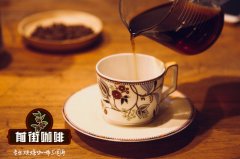Bourbon Coffee Basics: Which is Yellow Bourbon Yellow Bourbon Flavor Description

Professional coffee knowledge exchange more coffee bean information please follow the coffee workshop (Wechat official account cafe_style)
Bourbon coffee (French: Caf é Bourbon) is a kind of coffee produced by growing coffee trees in bourbon cultivation of Arabica coffee. Bourbon coffee was originally grown in Reunion, which was also known as le Bourbon Island before 1789. Later occupied by France to connect with the African continent and Latin America, it is now one of the two most popular producers of Arabica coffee in the world. Bourbon coffee is usually produced between 3500 and 6500 feet above sea level.
Bourbon species, native to Bourbon Island in the Indian Ocean (now known as Reunion Island), is the second species caused by Typica mutation. It belongs to the oldest existing coffee variety. The green fruit appears bright red when ripe, while the yellow bourbon species is derived from the cross between bourbon species and other varieties. Because of its low yield and relatively intolerant to wind and rain, it has not been widely planted. However, when planted in high altitude areas, it will have excellent flavor performance, which is more common in recent years.
Yellow Bourbon, Huang bourbon, the mature consequence is actually yellow, was first found in Brazil, and now mainly grows in Brazil. It is generally believed that it may have been mutated by a cross between a bourbon with red fruit and a variety of iron pickup with yellow fruit called "Amerelo de Botocatu".
Among the many varieties of coffee in Brazil, yellow bourbon is one of the most outstanding varieties. Generally speaking, yellow bourbon changes from green to yellow to red, but the appearance of yellow bourbon only stays in yellow. The yellow bourbon, which grows at high altitude and is sun-treated, has an excellent flavor.
Taste characteristics: sweet and smooth fruit sweetness, obvious nutty flavor, balanced and supple acidity, weak and clean bitterness, rich chocolate aroma and nutty flavor, bright and fresh taste.
Related recommendation: introduction of the difference between Brazilian yellow bourbon coffee beans by hand and red bourbon
Important Notice :
前街咖啡 FrontStreet Coffee has moved to new addredd:
FrontStreet Coffee Address: 315,Donghua East Road,GuangZhou
Tel:020 38364473
- Prev

Bourbon Coffee Where Bourbon Coffee is Produced History Stories and Variants Coffee Introduction
Professional coffee knowledge exchange More coffee bean information, please pay attention to coffee workshop (Weixin Official Accounts cafe_style) Bourbon species simply say what bourbon coffee is Bourbon coffee was originally grown on the island of Reunion, which was also known as le Bourbon until 1789. Bourbon species, a mutant subspecies of Typica, belongs to the oldest extant species with Typica
- Next

Pink bourbon is not bourbon coffee? What is the coffee powder bourbon? introduction to the taste characteristics of coffee powder bourbon
Professional coffee knowledge exchange more coffee bean information Please follow the coffee workshop (Wechat official account cafe_style) A coffee colleague visited yesterday. He just got back from Colombia, turned on his computer and showed us a lot of pictures of last year's best-selling powdered bourbon. Judging from the photo, it actually looks like a winter jujube that ripens slowly after a few days, unlike the hello kitty powder we imagined.
Related
- Beginners will see the "Coffee pull flower" guide!
- What is the difference between ice blog purified milk and ordinary milk coffee?
- Why is the Philippines the largest producer of crops in Liberia?
- For coffee extraction, should the fine powder be retained?
- How does extracted espresso fill pressed powder? How much strength does it take to press the powder?
- How to make jasmine cold extract coffee? Is the jasmine + latte good?
- Will this little toy really make the coffee taste better? How does Lily Drip affect coffee extraction?
- Will the action of slapping the filter cup also affect coffee extraction?
- What's the difference between powder-to-water ratio and powder-to-liquid ratio?
- What is the Ethiopian local species? What does it have to do with Heirloom native species?

